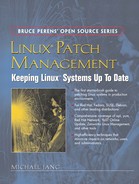Book Description
The Start-to-Finish Patch Management Guide for Every Linux® Environment
To keep your Linux systems secure, reliable, and productive, you must stay current with patches and updates. But, until now, it has been difficult to find usable, trustworthy guidance on managing patches in Linux production environments. Linux Patch Management fills that gap, offering Linux professionals start-to-finish solutions, strategies, and examples for every environment, from single computers to enterprise-class networks.
Michael Jang presents patching solutions for Red Hat, Fedora, SUSE, Debian, and other distributions. He systematically covers both distribution-specific tools and widely used community tools, such as apt and yum. This book’s streamlined patch management techniques minimize impacts on users, networks, and administrators, and address applications as well as the underlying OS. Whatever your role in managing Linux systems, Linux Patch Management will reduce your costs, enhance the availability of your systems, and dramatically improve your personal efficiency.
Consolidating patches on a Red Hat network, including cached updates, as well as patching systems based on RHEL rebuild distributions
Working with SUSE’s update systems, including YaST Online Update and Zenworks Linux Management
Making the most of apt commands and the GUI-based Synaptic Package Manager
Configuring apt for RPM distributions such as Fedora and SUSE Linux
Creating repositories that can manage gigabytes of patches on diverse Linux systems
Updating networks of Linux computers without overloading WAN or Internet connections
Configuring yum clients, including coverage of emerging GUI tools such as Yum Extender
Bruce Perens’ Open Source Series is a definitive series of Linux and open source books by the world’s leading Linux professionals. Bruce Perens is the primary author of The Open Source Definition, the formative document of the open source movement, and the former Debian GNU/Linux Project Leader.
Series Editor Bruce Perens is an open source evangelist, developer, and consultant whose software is a major component of most commercial embedded Linux offerings. He founded or cofounded Linux Standard Base, Open Source Initiative, and Software in the Public Interest. As Debian GNU/Linux Project Leader, he was instrumental in getting the system on two U.S. space shuttle flights.
© Copyright Pearson Education. All rights reserved.
Table of Contents
- Copyright
- Bruce Perens’ Open Source Series
- About the Author
- Preface
- Acknowledgments
- 1. Patch Management Systems
- 1.1. Basic Patch Concepts
- 1.2. Distribution-Specific Repositories
- 1.2.1. Red Hat Enterprise Linux Updates
- Register with the Red Hat Network
- Examine Available Red Hat Enterprise Linux Distributions
- Purchase One or More Subscriptions for RHEL
- Activate Your Subscription
- Download the CDs for RHEL
- Installing Red Hat Enterprise Linux
- The Update Agent
- Updating Red Hat Enterprise Linux Using the Update Agent
- Configuring the Update Agent Settings
- Update Agent Command Line Options
- Aggregating Red Hat Enterprise Linux Updates
- 1.2.2. Novell/SUSE
- 1.2.3. Debian
- 1.2.4. Other Linux Distributions
- 1.2.1. Red Hat Enterprise Linux Updates
- 1.3. Community-Based Sources
- 1.4. Configuring Your Lan
- 1.5. Summary
- 2. Consolidating Patches on a Red Hat/Fedora Network
- 2.1. Creating Your Own Fedora Repository
- 2.2. Configuring a Red Hat Network Proxy
- 2.2.1. Configuring the Proxy Server
- Specialized Installation Requirements
- Configuration Suggestions
- Firewall Provisions
- Synchronizing Time
- Configuring the Proxy as a Router
- Registration Required
- Getting to the Right Channel
- Installing Proxy Packages
- Provisioning a Proxy Subscription
- Configuring the Proxy Server
- Creating the Certificate Keys
- 2.2.2. Configuring the Proxy Client
- 2.2.1. Configuring the Proxy Server
- 2.3. Configuring Red Hat Rebuilds
- 2.4. Summary
- 3. SUSE’s Update Systems and rsync Mirrors
- 3.1. The YaST Update System
- 3.2. Configuring YaST Patch Management for a LAN
- 3.3. ZENworks Linux Management
- 3.4. Summary
- 4. Making apt Work for You
- 4.1. Fundamentals of APT
- 4.2. Creating Your APT Repository
- 4.3. Summary
- 5. Configuring apt for RPM Distributions
- 6. Configuring a yum Client
- 6.1. The Basic yum Process
- 6.2. Sample yum Clients
- 6.3. Special yum Commands
- 6.3.1. Caching Available Packages by yum
- 6.3.2. Checking Available Updates by yum
- 6.3.3. Finding a Needed File
- 6.3.4. Identifying a Needed Package
- 6.3.5. Listing Available Packages
- 6.3.6. Getting More Information
- 6.3.7. Updates or Installations by yum
- 6.3.8. Deletions by yum
- 6.3.9. Cleaning yum Caches
- 6.3.10. Group Management by yum
- 6.3.11. The yum Command Options
- 6.4. Configuring Automatic Updates
- 6.5. A yum GUI Tool
- 6.6. Summary
- 7. Setting Up a yum Repository
- 7.1. Getting the Packages
- 7.2. Managing Headers
- 7.3. Configuring a Local yum Server
- 7.4. Adding Other Repositories
- 7.5. Maintaining the Repository
- 7.6. Creating an Enterprise Repository
- 7.7. Summary
